Who is ready to be rid of 2020? It has been a very stress-filled year for pretty much everyone on our little blue planet. After a run on toilet paper and hand sanitizer, most of us in Washington became shut-is for several months. Trips to the grocery and walks around the neighborhoods were the only things we could do. People grew angry and we saw the worst in selfish human behavior. We watched in horror as the life of another unarmed black man was choked out of him and the global riots of people angered by his needless death. But we also saw the good in people too. We experienced communities coming together to help each other out. We saw friends and families who found safe ways to gather and share. We found new ways to bond as humans. As I began to stretch my boundaries and my legs, I gained a new appreciation of our natural world. This was a year I truly embraced the forested landscape ass a photographic subject. Nearly ever page in my calendar is of our wondrous forest. So come with me as I look back through my 12 favorite images I created this past year.

Our year started out with hope and enthusiasm for the new year. One of my first outing was with a photography meetup group based in Seattle. We explored one of the industrial areas of Seattle and I had my eye on trying to look at a the world from different angle. That's when this jumble of rusty rebar and colorful nuts caught my eye. I tried several different angles but this topsy-turvy one was my favorite from the batch. Who would have thought that our world would soon be topsy-turvy itself. While we were mourning the loss of a great family man and basketball player, a more insidious threat was sneaking up on us. Not long after I created this image, I was bed-ridden likely with what was to lay the population of the world to rest. It was months later when I started putting 2 and 2 together and realized I most likely had COVID-19 and lost nearly a month to illness. Thankfully I recovered, but sadly most did not. But I look at this image not with the dread of what was coming, but the hope of something new and exciting to come s I walked into 2020 focused on the possibilities.
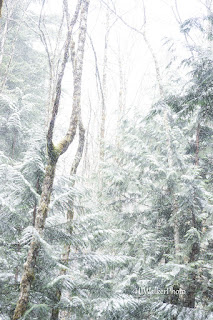
Knowing we had many miles to travel on our feet this summer, my sister and I began to train and get ourselves into condition. We brought along friends who we'd hope would be able to come with us on our traverses of the Olympic Mountains. One fine and beautiful day in March, just before the shut down orders, 5 of us hiked a favorite early season conditioning hike near Lake Cushman. The day was glorious as we set off up the trail. Sunlight streamed through the forest. As we climbed further into the forest and hills, a soft drizzle reminded us that it is spring in the Pacific Northwest. Soon small white flakes began drifting down through the forest. It was magical, just magical. I look at this photo and remember the wonders of nature and the comradery of friendship.
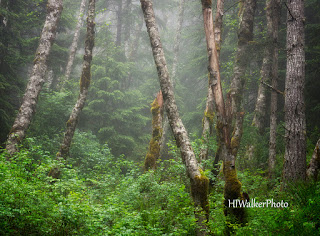
Ahh, Freedom at last! After what seemed like years under stay at home orders, we were able to hit the trails again. My sister and I started back into conditioning, but we had lost months and felt as if we were starting from square 1. One of our first hikes back was the Lower Big Quilcene River Trail to the old shelter site and back. Since it was a healthy Washington State spring, we hiked in light mist nearly the entire way. However, the day wasn't dark and dreary day - the trail was filled with a glowing light of spring growth and Pacific Rhododendrons. What I love about this scene is the simple reminder that the world is a beautiful place even in the most mundane scenes.
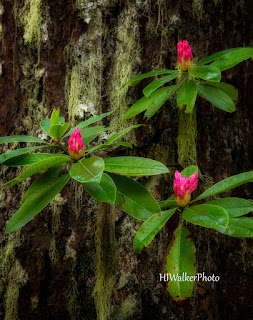
Speaking of Pacific Rhododendrons - I absolutely live spring in the Pacific Northwest when these pink beauties are blooming. They are the very essence of wild as they reach up through the dark forest - long gangly branches looking like a teenager performing stunts on a skateboard. The smooth green leaves contrast with rough furrowed bark of the surrounding trees. Pink blossoms contrast with the dark greens. my heart lifts when I see them. We hiked a favorite Rhodie hike during the peak season and I found these three blooms making a perfect equilateral triangle against the thick rough bark of a douglas-fir.

On Father's Day, my sister and I journeyed with our friend Holly to Fort Worden. It was her first Father's Day without her father. As we hiked through this large meadow before heading up to Battery Hill, I spied this fabulous Madrone tree at the edge of the forest. The red against the green made a striking image. But I also thought of my friend who was now several paces ahead and her striking resilience for all that she had experienced in her life. I do love Madrone trees for their ability to thrive in some of the harshest conditions. Holly has lived through personal and family tragedies and has come out stronger for herself and those who need her. I will forever see her in this image.
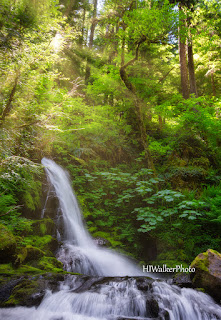
The first of our long treks was postponed due to COVID concerns. But we had to get out. My suggestion was to load up the dogs in Kristi's Jeep and find a dispersed camping site near Mt Rainier National Park. We found a not-so quite creek-side spot on Skate Creek Road and relaxed - soaking in the smells and sounds of nature. Always wanting to explore an area, we started to hike around where we camped and found this gorgeous waterfall. As I looked up, the sun broke through the clouds and trees for an epic image. I am reminded that when plans change, we can look somewhere else for an adventure.
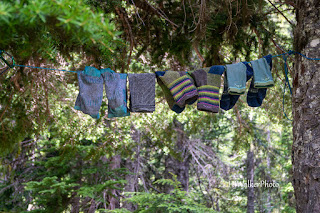
Just a clothesline with socks? To me this is much more. I have been wanting to explore the backcountry of Olympic National Park nearly all my life. I think I was about 8 when I met a woman who had hiked all the trails in the park. My eyes sparkled with the opportunity until my mother told me about the realities of such a venture. As an adult I re-awakened the dream. I had made a few backcountry incursions - a few miles over a weekend here and there. This? This was a 9-day adventure for me and my sis. We would travel up one river valley, sleep on a mountain ridge, see 4 bear, get soaked through and come out another river valley. We hung our socks up to dry (and air out) on day 6. It's a simple photo, but it is a reminder of the realities of such a venture and that dreams are still worth the effort.

This was a year that I embraced forest photography. I embraced the gloom of grey days in the forest. I embraced looking for where the light enhanced the scene. I embraced composing for the light in the scene. With this image, I began to feel as if something was beginning to work. I felt myself become excited for the prospect of another long walk through the woods on a dark and grey day. I also thought this image summed up the year for me - it was a dark year full of anxieties and illness but light still shined through.
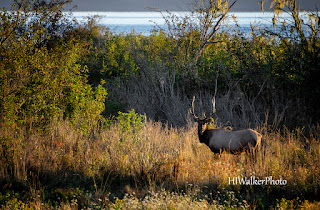
I had always heard of the Dosewallips elk herd but had never seen it. A trip to the park after a failed attempt at a thru-hike of the Olympics gave me the sight I had been hoping for. We checked into the park and I asked about the herd, if it had come into the lowlands yet. I was told that not only were they in the park but they cows had adopted a baby deer and were raising it. It was with hope of seeing this little adopted deer that sent me out early in the morning searching for the herd. I didn't have to look far and was soon watching them from the safety of a wildlife viewing platform. I did see the deer trotting along with the heard, but it was this image of the bull standing in the meadow at sunrise that made me swoon.
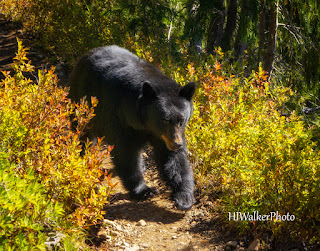
If safety was a concern with the elk herd, it was imperative with this guy. My sister and I saw 11 bear over the summer - 5 just on our trip to the High Divide in the Olympics. We set out on a long weekend with friends and were traversing the ridge on day 2 when this guy came rambling down the trail. We tried to remind him that it was our trail, but he reminded us that this was his home. He sauntered past us just feet away, stopping occasionally to nibble berries off the bushes. He's gorgeous. After he passed us, we high fived each other and yelled down the trail to warn the next group of hikers. My adrenaline and joy gushed the rest of the way to camp.
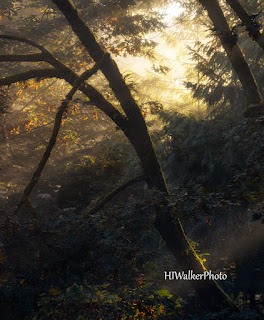
I love the simpleness of this image. I love how the shafts of sunlight warm the sky and caress the trunk at the bottom of the frame. I had been hoping all autumn for some foggy days and was rewarded on a trip with friends to Whatcom Falls Park in Bellingham. It was my first visit and while I loved the images of the falls, this image of light streaming through the trees made my heart sing.
And if it's simpleness you want, what could be more simple the a single cobweb covered in dew stretching from dried buds and raindrops to . . . well, who really cares? I found this on a day where the light in the forest made even the most mundane subject look special. In one small area, dew drops and cobwebs filled my camera's sensor and I was lost in the beauty of nothing.
I truly hope you enjoyed revisiting some of my favorite adventures and images of a year the was hard and joyous. Be well. Keep yourself and others safe. And here's to a better 2021. Heidi

















